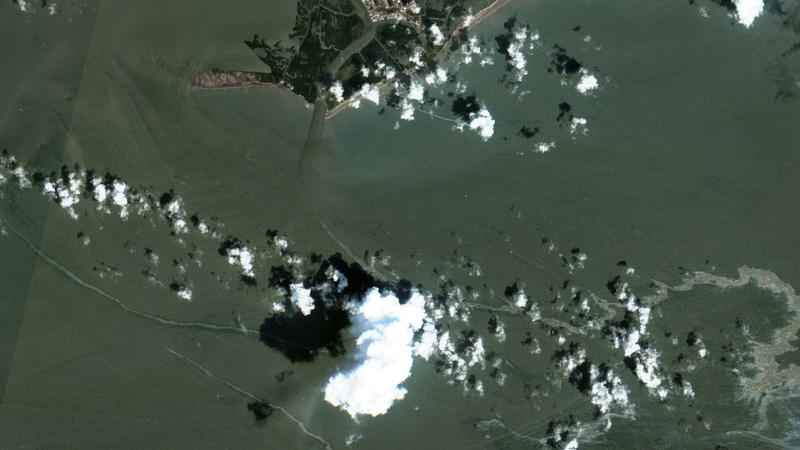Divers identify broken pipeline as source of Gulf oil spill

In a satellite image provided by Maxar Technologies, an oil slick is shown on Sept. 2, 2021 south of Port Fourchon, La. The U.S. Coast Guard said Saturday, Sept. 4, that cleanup crews are responding to a sizable oil spill in the Gulf of Mexico following Hurricane Ida.[Maxar Technologies via AP]
Divers at the site of an ongoing oil spill that appeared in the Gulf of Mexico after Hurricane Ida have identified the apparent source as a 1-foot diameter pipeline displaced from a trench on the ocean floor and broken open.
Talos Energy, the Houston-based company currently paying for the cleanup, said in a statement issued Sunday evening that the busted pipeline does not belong to them.
The company said it is working with the U.S. Coast Guard and other state and federal agencies to coordinate the response and identify the owner of the ruptured pipeline.
Two additional 4-inch pipelines were also identified in the area that are open and apparently abandoned. The company’s statement did not make clear if oil was leaking from the two smaller pipelines, but satellite images reviewed by The Associated Press on Saturday appeared to show at least three different slicks in the same area, the largest drifting more than a dozen miles eastward along the Gulf coast.
The AP first reported Wednesday that aerial photos showed a miles-long brown and black oil slick spreading about 2 miles south of Port Fourchon, Louisiana. The broken pipe is in relatively shallow water, at about 34 feet of depth.
Talos said the rate of oil appearing on the surface had slowed dramatically in the last 48 hours and no new heavy black crude had been seen in the last day.
So far, the spill appears to have remained out to sea and has not impacted the Louisiana shoreline. There is not yet any estimate for how much oil was in the water.
The Coast Guard said Saturday its response teams are monitoring reports and satellite imagery to determine the scope of the discharge, which is located in Bay Marchand, Block 4. Talos previously leased Bay Marchand, Block 5, but ceased production there in 2017, plugged its wells and removed all pipeline infrastructure by 2019, according to the company.
The area where the spill is located has been drilled for oil and gas for decades. Federal leasing maps show it contains a latticework of old pipelines, plugged wells and abandoned platforms, along with newer infrastructure still in use.
With the source of the oil unclear, Talos hired Clean Gulf Associates to respond to the spill. Clean Gulf, a nonprofit oil-spill response cooperative that works with the energy exploration and production industry, has had two 95-foot vessels at the scene of the spill since Wednesday attempting to contain and recover crude from the water.
The Bay Marchand spill is one of dozens of reported environmental hazards state and federal regulators are tracking in Louisiana and the Gulf following the Category 4 hurricane that made landfall at Port Fourchon a week ago. The region is a major production center of the U.S. petrochemical industry.
The AP also first reported Wednesday on images from a National Atmospheric and Oceanic Survey that showed extensive flooding and what appeared to be petroleum in the water at the sprawling Phillips 66 Alliance Refinery located along the Mississippi River south of New Orleans.
After AP published the photos, the Environmental Protection Agency tasked a specially outfitted survey aircraft to fly over that refinery on Thursday, as well as other industrial sites in the area hardest hit by the hurricane’s 150-mph winds and storm surge.
The Louisiana Department of Environmental Quality said a state assessment team sent to the Alliance Refinery observed a spill of heavy oil being addressed with booms and absorbent pads. A levee meant to protect the plant had breached, allowing floodwaters to flow in during the storm and then back out as the surge receded.
State environmental officials said there was also no estimate yet available for how much oil might have spilled from the Phillips 66 refinery.